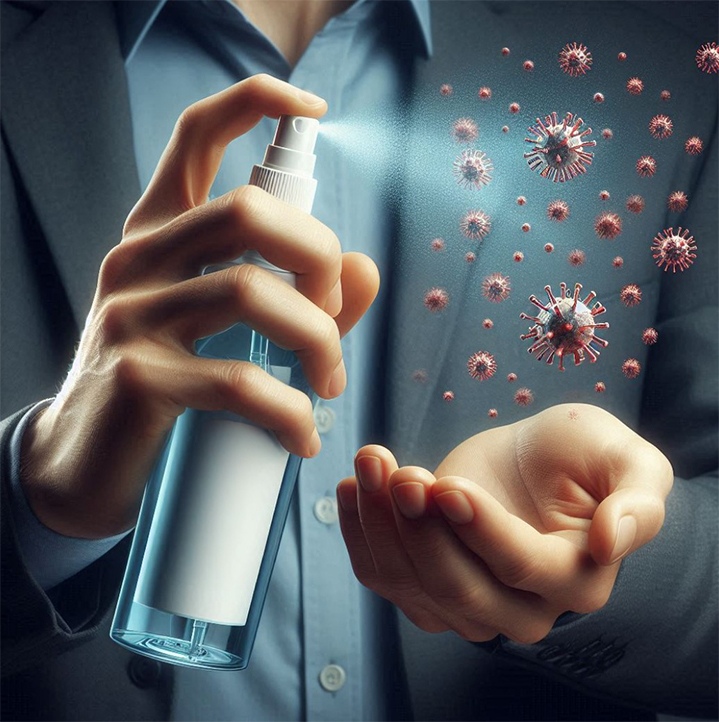
When it comes to keeping ourselves and our environment clean, we often rely on products labeled as antibacterial or antimicrobial. While these terms are often used interchangeably, there is actually a significant difference between the two.
Antibacterial products are designed to target and eliminate bacteria, while antimicrobial products have a broader scope and can also target other microorganisms such as viruses, fungi, and parasites. Understanding this difference is important in choosing the right product for our needs and avoiding potential health risks associated with overuse of these products.
Antibacterial products are designed to target and kill bacteria
Bacteria are single-celled microorganisms that can be found almost everywhere, including on our skin, in our bodies, and in the environment. While some types of bacteria are beneficial for our health, others can cause infections and illness.
Antibacterial products work by using chemicals or natural substances that inhibit or kill bacteria. These products come in various forms, such as hand sanitizers, soaps, and cleaning solutions. They are commonly used in healthcare settings to prevent the spread of infections and are also popular among households for everyday use.
The main active ingredient in antibacterial products is usually either alcohol or triclosan. Alcohol-based products target a wide range of bacteria by breaking down their cell walls, which can cause them to burst and die. Triclosan, on the other hand, is a chemical that disrupts bacterial function and ultimately kills them.
Terms that are often used interchangeably with antibacterial include “antibiotic” (when referring to medications used in humans or animals) and “bactericide.”
Common Settings and Uses:
- Healthcare Facilities: Antibacterial products are commonly used in hospitals, clinics, and other healthcare settings to prevent the spread of bacterial infections.
- Household Cleaning: Products such as antibacterial soaps and surface cleaners are popular for everyday use in homes to maintain hygiene.
- Food Industry: These products are essential in food processing and preparation areas to ensure that surfaces and equipment are free from harmful bacteria that could cause foodborne illnesses.
Best Solutions For:
- Preventing Infections: In settings where there is a high risk of bacterial infections, such as hospitals and clinics, antibacterial products help in reducing the likelihood of infection.
- Everyday Hygiene: Regular use of antibacterial soaps and cleaners can help reduce the number of bacteria on hands and surfaces, contributing to overall cleanliness and health.
Antimicrobial products have a broader spectrum of action and can target a wider range of microorganisms
In addition to bacteria, They are designed to kill or inhibit the growth of a wide range of microorganisms, including bacteria, viruses, fungi, and protozoans. This makes them more versatile and useful for various purposes.
Antimicrobial products work by using chemicals or natural substances that disrupt the growth or function of microorganisms. They are commonly used in healthcare settings, food production facilities, and households to prevent the spread of infections and diseases.
The main active ingredients in antimicrobial products vary depending on the target microorganism. For example, an antiviral product may contain substances that interfere with viral replication, while an antifungal product may use chemicals that inhibit fungal growth.
This category includes antiseptics, antibiotics, antivirals, antifungals, and antiparasitics.
Distinguishing Between FDA-Regulated and EPA-Regulated Antimicrobial Products
Antimicrobial products are designed to kill or inhibit the growth of microorganisms, including bacteria, viruses, fungi, and protozoans. The regulation of these products in the United States falls under two primary agencies: the U.S. Environmental Protection Agency (EPA) and the U.S. Food and Drug Administration (FDA). Understanding the difference between these regulatory frameworks is essential for appropriate application and compliance.
EPA-regulated antimicrobial products are considered pesticides
They are used on non-living objects and surfaces to control or eliminate microbes. Examples include:
- Surface Disinfectants: Products used on countertops, bathroom surfaces, and medical equipment to disinfect and reduce microbial contamination.
- Sanitizers: Used on surfaces like cutting boards and high chairs to reduce the number of bacteria to safe levels, especially in food preparation areas.
- Sterilizers: Stronger products used in medical and research settings to eliminate all forms of microbial life, including spores.
Settings and Best Solutions:
- Public Health Settings: Hospitals, clinics, and other healthcare environments use EPA-regulated disinfectants and sterilizers to prevent infections and control pathogens on surfaces and medical instruments.
- Residential and Commercial Spaces: Surface sanitizers and disinfectants are commonly used in homes, schools, offices, and restaurants to maintain hygiene and reduce the risk of disease transmission.
- Industrial Applications: Used in water treatment facilities, cooling towers, and manufacturing processes to control microbial growth and prevent spoilage or contamination.
EPA-regulated products must display an EPA registration number and provide detailed instructions for safe and effective use, including first aid instructions in case of accidental exposure.
FDA-regulated antimicrobial products are classified as drugs or antiseptics
They are intended for use on living tissues to prevent or treat infections. Examples include:
- Hand Sanitizers: Alcohol-based sprays, gels and wipes used to reduce bacteria on the skin.
- Topical Antiseptics: Products like iodine or hydrogen peroxide used to clean wounds and prevent infection.
- Antimicrobial Soaps: Soaps containing antibacterial agents for handwashing.
Settings and Best Solutions:
- Healthcare: Used extensively in hospitals and clinics for hand hygiene among healthcare workers and for pre-surgical skin preparation.
- Personal Care: Commonly found in households for everyday use to maintain personal hygiene and prevent the spread of germs.
- Pet Care: Products like antimicrobial shampoos and sprays are used to treat or prevent infections in pets.
FDA-regulated products must comply with stringent safety and efficacy standards and include detailed labeling to ensure proper use and application on living tissues.
The difference between EPA and FDA-regulated antimicrobial products is in their intended use and regulatory oversight.
EPA-regulated products are used on non-living surfaces and objects to control or eliminate microbes, making them ideal for disinfecting and sanitizing environments. On the other hand, FDA-regulated products are used on living tissues to prevent or treat infections, making them essential for personal and healthcare use. Understanding these distinctions ensures the correct application and maximizes the effectiveness of antimicrobial interventions.
Difference Between Antibacterial and Antimicrobial Products
The main difference between antibacterial and antimicrobial products lies in their spectrum of action. While both types target microorganisms, antibacterial products specifically focus on bacteria, while antimicrobial products have a broader range that also includes viruses, fungi, and parasites.
Another significant difference is the active ingredients used in these products. Antibacterial products commonly use alcohol or triclosan, while antimicrobial products can have a variety of substances depending on the target microorganism.
It is also essential to note that overuse and misuse of both types of products can lead to adverse effects. For instance, using antibacterial products excessively may contribute to the development of antibiotic-resistant bacteria, while overusing antivirals can lead to the emergence of drug-resistant viruses.
Also, while both types of products can be useful in preventing the spread of infections and illness, they are not a substitute for proper hygiene practices. Regular hand-washing with soap and water is still considered the most effective method for removing germs and preventing the spread of disease.
Does it Matter Which One You Use?
It depends on your needs and situation. Make sure to read the manufacturer’s label and follow the instructions for use. If you’re looking for a product to use in everyday cleaning, then either an antibacterial or antimicrobial product may be suitable.
However, if you are dealing with a specific type of microorganism, such as a bacterial infection or a viral outbreak, then be sure to use the appropriate product that specifically targets that microorganism.

Tips for using Antibacterial and Antimicrobial Products Responsibly
There are several tips to keep in mind when using antibacterial and antimicrobial products responsibly.
- Follow instructions: Always read and follow the instructions on these products carefully. Using too much or using them in a way that is not recommended can lead to potential risks.
- Avoid overuse: Using too many antibacterial or antimicrobial products can contribute to the development of resistant strains and pose a threat to public health. Use them only when necessary.
- Choose products wisely: Look for products that have been approved by regulatory bodies, such as the FDA, and contain safe and effective ingredients.
- Practice proper hygiene: Regular hand-washing, covering your mouth when coughing or sneezing, and cleaning frequently touched surfaces are all important practices to prevent the spread of infections and diseases. Use Common Sense long lasting hand sanitizer for hours of protection and in situations when you do not have access to soap and water.
- Consult with a healthcare professional: If you have concerns about using these products or if you have a weakened immune system, it is best to consult with a healthcare professional for guidance on the appropriate use of antibacterial and antimicrobial products.
By following these tips, we can ensure that we are using these products responsibly and helping to prevent potential risks such as antibiotic resistance. Good hygiene practices and responsible use of antibacterial and antimicrobial products go hand in hand in keeping ourselves and our communities healthy.
The appropriate use of antimicrobial products is essential for maintaining hygiene and preventing the spread of harmful microorganisms.
Among these products, Common Sense hand sanitizer stands out as a safe and effective solution. Its long-lasting antimicrobial action reduces the need for frequent reapplication, minimizing overuse and promoting more sustainable hygiene practices.
Microbe Solutions’ commercial and residential disinfection services leverage the power of Common Sense surface disinfectant products. These services ensure thorough and reliable microbial control across various environments, from homes and schools to offices and healthcare facilities. By choosing Common Sense products and Microbe Solutions’ services, consumers and businesses can confidently safeguard their spaces against harmful pathogens, contributing to a healthier, cleaner world.
FAQs
Are all bacteria harmful?
No, not all bacteria are harmful. In fact, our bodies also contain beneficial bacteria that play important roles in maintaining our health.
Are Microbe Solutions’ products safe to use?
Yes, our products are environmentally safe and non-toxic. We prioritize the safety and well-being of our clients and follow recommended protocols for infection control. So, you can trust us to provide effective yet safe solutions for your sanitation needs.

